Economic Policy Analysis: Capital Market and Real Estate Impact Report
VerifiedAdded on 2020/04/15
|9
|1704
|36
Report
AI Summary
This report provides an analysis of the capital market and real estate, focusing on the impact of economic policies. It examines the effects of fiscal and monetary policies on the housing market, interest rates, and investment. The report includes discussions on the multiplier effect, crowding-out effects, and the role of government spending. Furthermore, it delves into the causes and consequences of the 2008 Global Financial Crisis, particularly the housing bubble in the United States. The analysis covers contributing factors to the crisis, such as investor speculation, low-interest rates, and housing tax policies. The report also explores the impact of monetary policy changes and government programs on the real estate market in Canada. References are provided to support the analysis of the complex interplay between economic policies, capital markets, and real estate dynamics, offering insights into the factors that influence economic welfare and stability.
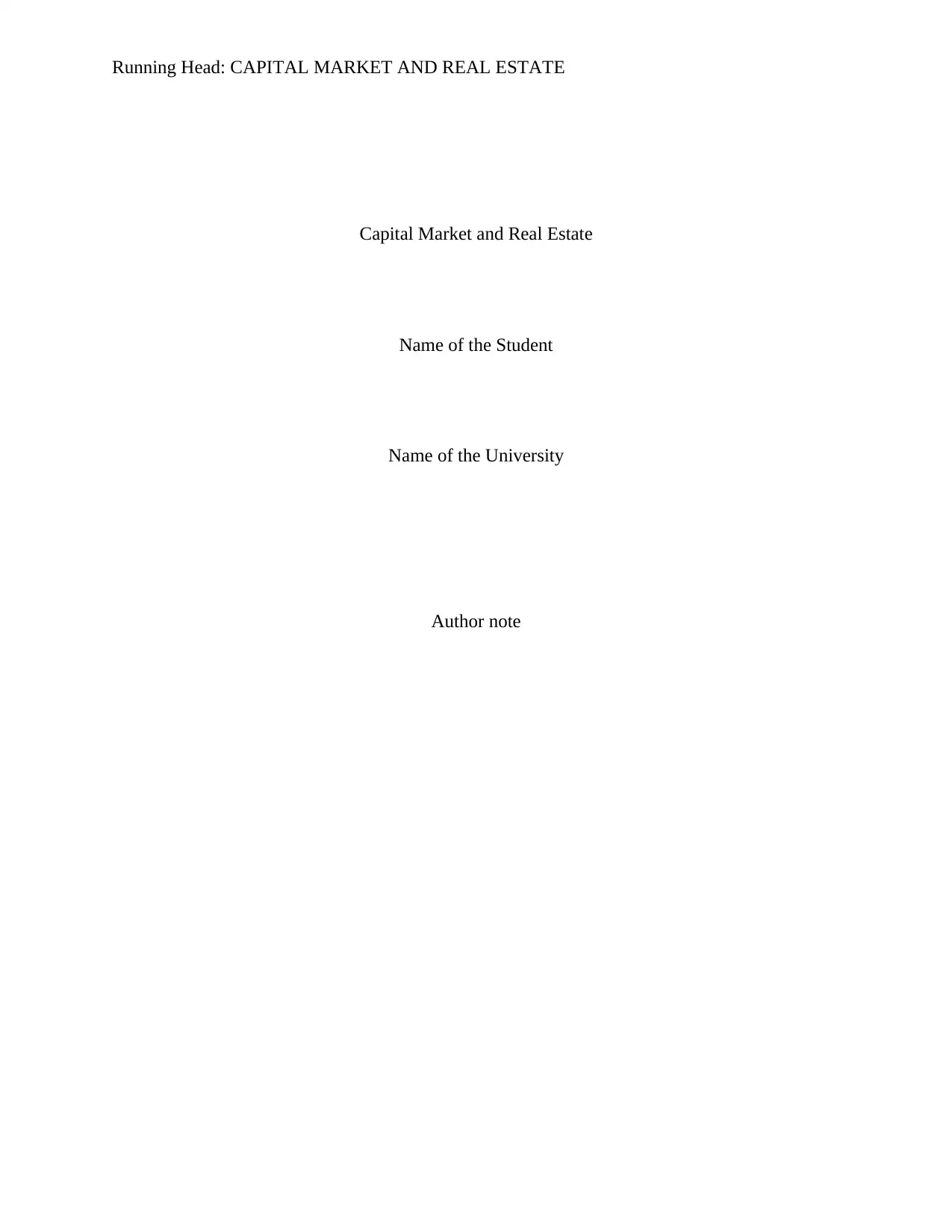
Running Head: CAPITAL MARKET AND REAL ESTATE
Capital Market and Real Estate
Name of the Student
Name of the University
Author note
Capital Market and Real Estate
Name of the Student
Name of the University
Author note
Paraphrase This Document
Need a fresh take? Get an instant paraphrase of this document with our AI Paraphraser
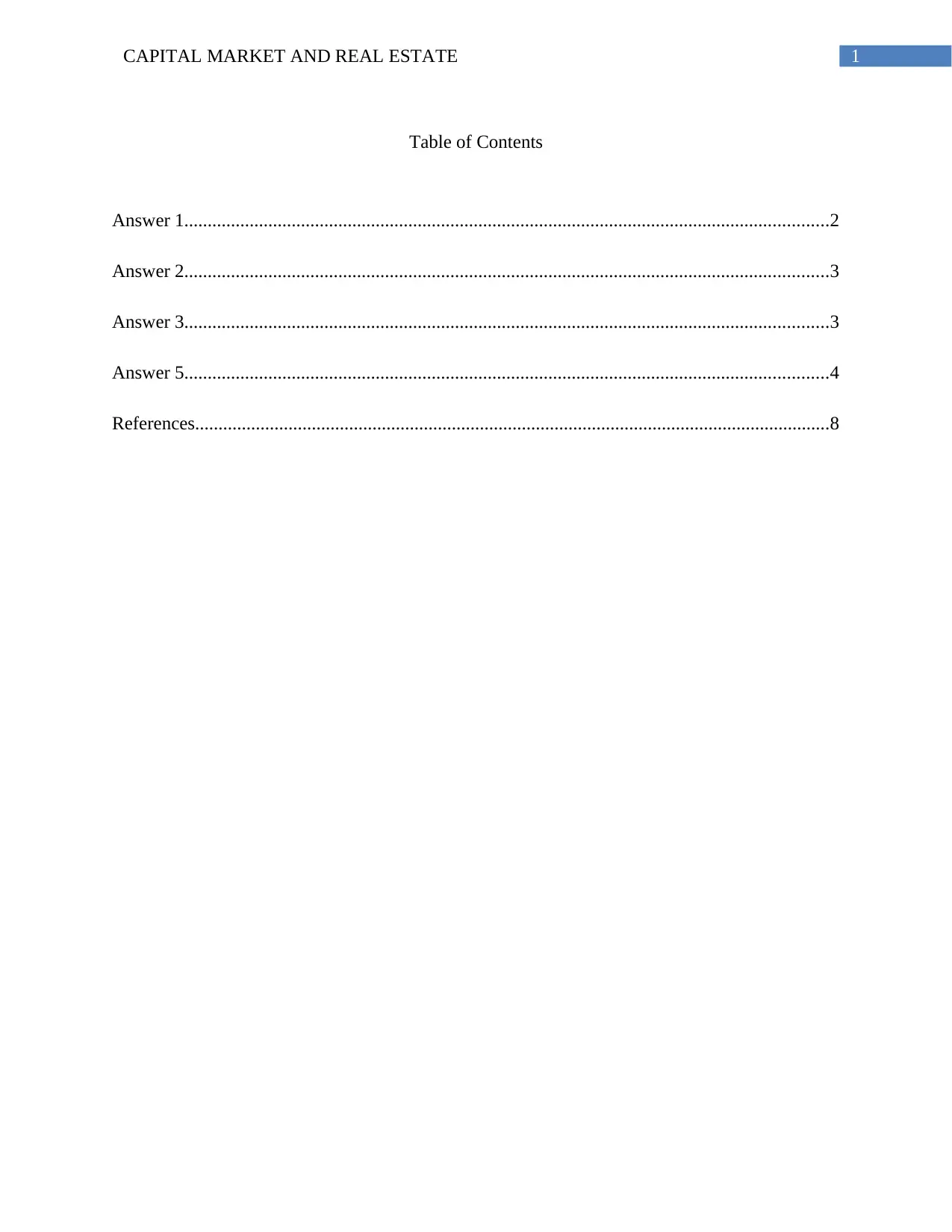
1CAPITAL MARKET AND REAL ESTATE
Table of Contents
Answer 1..........................................................................................................................................2
Answer 2..........................................................................................................................................3
Answer 3..........................................................................................................................................3
Answer 5..........................................................................................................................................4
References........................................................................................................................................8
Table of Contents
Answer 1..........................................................................................................................................2
Answer 2..........................................................................................................................................3
Answer 3..........................................................................................................................................3
Answer 5..........................................................................................................................................4
References........................................................................................................................................8
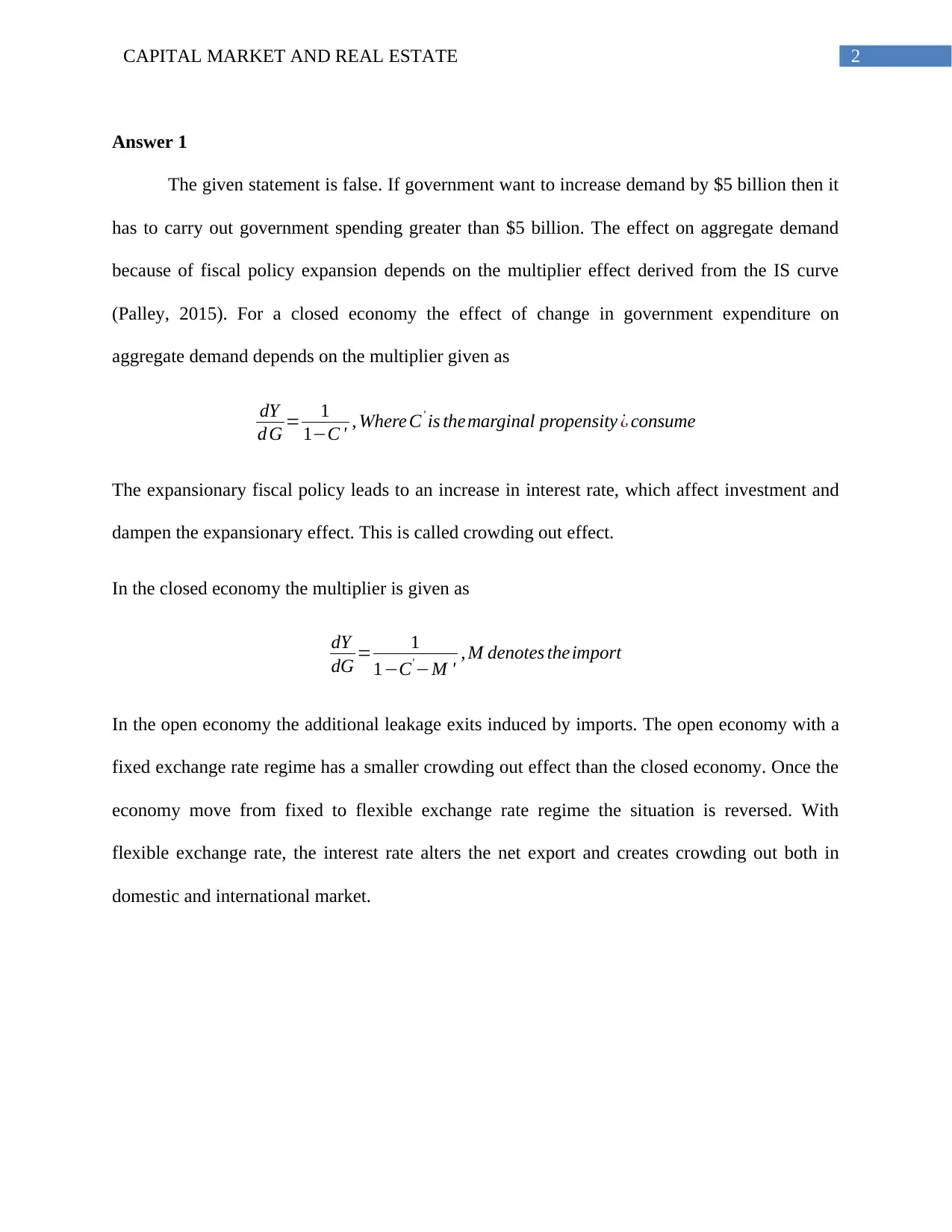
2CAPITAL MARKET AND REAL ESTATE
Answer 1
The given statement is false. If government want to increase demand by $5 billion then it
has to carry out government spending greater than $5 billion. The effect on aggregate demand
because of fiscal policy expansion depends on the multiplier effect derived from the IS curve
(Palley, 2015). For a closed economy the effect of change in government expenditure on
aggregate demand depends on the multiplier given as
dY
d G = 1
1−C ' , Where C' is themarginal propensity ¿ consume
The expansionary fiscal policy leads to an increase in interest rate, which affect investment and
dampen the expansionary effect. This is called crowding out effect.
In the closed economy the multiplier is given as
dY
dG = 1
1−C'−M ' , M denotes theimport
In the open economy the additional leakage exits induced by imports. The open economy with a
fixed exchange rate regime has a smaller crowding out effect than the closed economy. Once the
economy move from fixed to flexible exchange rate regime the situation is reversed. With
flexible exchange rate, the interest rate alters the net export and creates crowding out both in
domestic and international market.
Answer 1
The given statement is false. If government want to increase demand by $5 billion then it
has to carry out government spending greater than $5 billion. The effect on aggregate demand
because of fiscal policy expansion depends on the multiplier effect derived from the IS curve
(Palley, 2015). For a closed economy the effect of change in government expenditure on
aggregate demand depends on the multiplier given as
dY
d G = 1
1−C ' , Where C' is themarginal propensity ¿ consume
The expansionary fiscal policy leads to an increase in interest rate, which affect investment and
dampen the expansionary effect. This is called crowding out effect.
In the closed economy the multiplier is given as
dY
dG = 1
1−C'−M ' , M denotes theimport
In the open economy the additional leakage exits induced by imports. The open economy with a
fixed exchange rate regime has a smaller crowding out effect than the closed economy. Once the
economy move from fixed to flexible exchange rate regime the situation is reversed. With
flexible exchange rate, the interest rate alters the net export and creates crowding out both in
domestic and international market.
⊘ This is a preview!⊘
Do you want full access?
Subscribe today to unlock all pages.

Trusted by 1+ million students worldwide
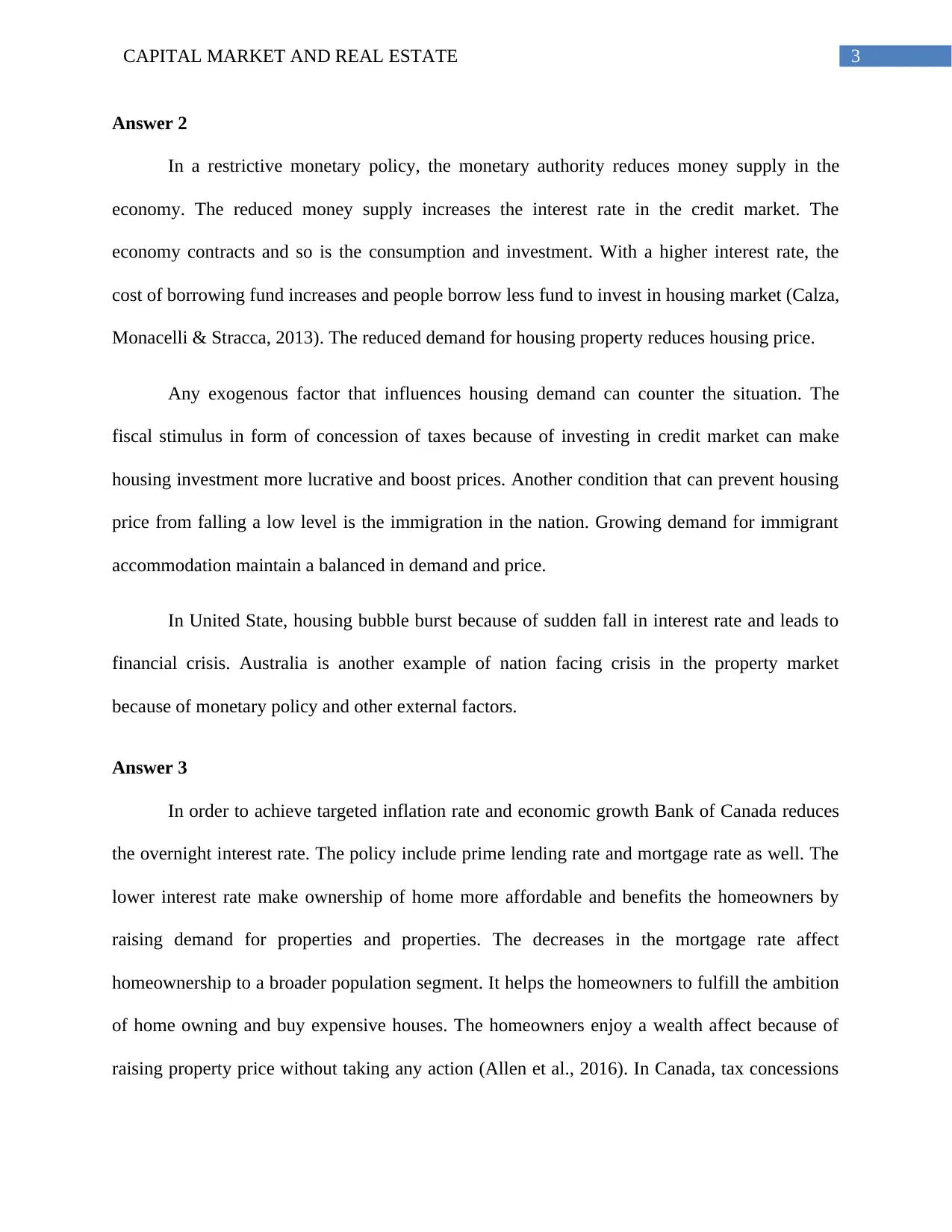
3CAPITAL MARKET AND REAL ESTATE
Answer 2
In a restrictive monetary policy, the monetary authority reduces money supply in the
economy. The reduced money supply increases the interest rate in the credit market. The
economy contracts and so is the consumption and investment. With a higher interest rate, the
cost of borrowing fund increases and people borrow less fund to invest in housing market (Calza,
Monacelli & Stracca, 2013). The reduced demand for housing property reduces housing price.
Any exogenous factor that influences housing demand can counter the situation. The
fiscal stimulus in form of concession of taxes because of investing in credit market can make
housing investment more lucrative and boost prices. Another condition that can prevent housing
price from falling a low level is the immigration in the nation. Growing demand for immigrant
accommodation maintain a balanced in demand and price.
In United State, housing bubble burst because of sudden fall in interest rate and leads to
financial crisis. Australia is another example of nation facing crisis in the property market
because of monetary policy and other external factors.
Answer 3
In order to achieve targeted inflation rate and economic growth Bank of Canada reduces
the overnight interest rate. The policy include prime lending rate and mortgage rate as well. The
lower interest rate make ownership of home more affordable and benefits the homeowners by
raising demand for properties and properties. The decreases in the mortgage rate affect
homeownership to a broader population segment. It helps the homeowners to fulfill the ambition
of home owning and buy expensive houses. The homeowners enjoy a wealth affect because of
raising property price without taking any action (Allen et al., 2016). In Canada, tax concessions
Answer 2
In a restrictive monetary policy, the monetary authority reduces money supply in the
economy. The reduced money supply increases the interest rate in the credit market. The
economy contracts and so is the consumption and investment. With a higher interest rate, the
cost of borrowing fund increases and people borrow less fund to invest in housing market (Calza,
Monacelli & Stracca, 2013). The reduced demand for housing property reduces housing price.
Any exogenous factor that influences housing demand can counter the situation. The
fiscal stimulus in form of concession of taxes because of investing in credit market can make
housing investment more lucrative and boost prices. Another condition that can prevent housing
price from falling a low level is the immigration in the nation. Growing demand for immigrant
accommodation maintain a balanced in demand and price.
In United State, housing bubble burst because of sudden fall in interest rate and leads to
financial crisis. Australia is another example of nation facing crisis in the property market
because of monetary policy and other external factors.
Answer 3
In order to achieve targeted inflation rate and economic growth Bank of Canada reduces
the overnight interest rate. The policy include prime lending rate and mortgage rate as well. The
lower interest rate make ownership of home more affordable and benefits the homeowners by
raising demand for properties and properties. The decreases in the mortgage rate affect
homeownership to a broader population segment. It helps the homeowners to fulfill the ambition
of home owning and buy expensive houses. The homeowners enjoy a wealth affect because of
raising property price without taking any action (Allen et al., 2016). In Canada, tax concessions
Paraphrase This Document
Need a fresh take? Get an instant paraphrase of this document with our AI Paraphraser
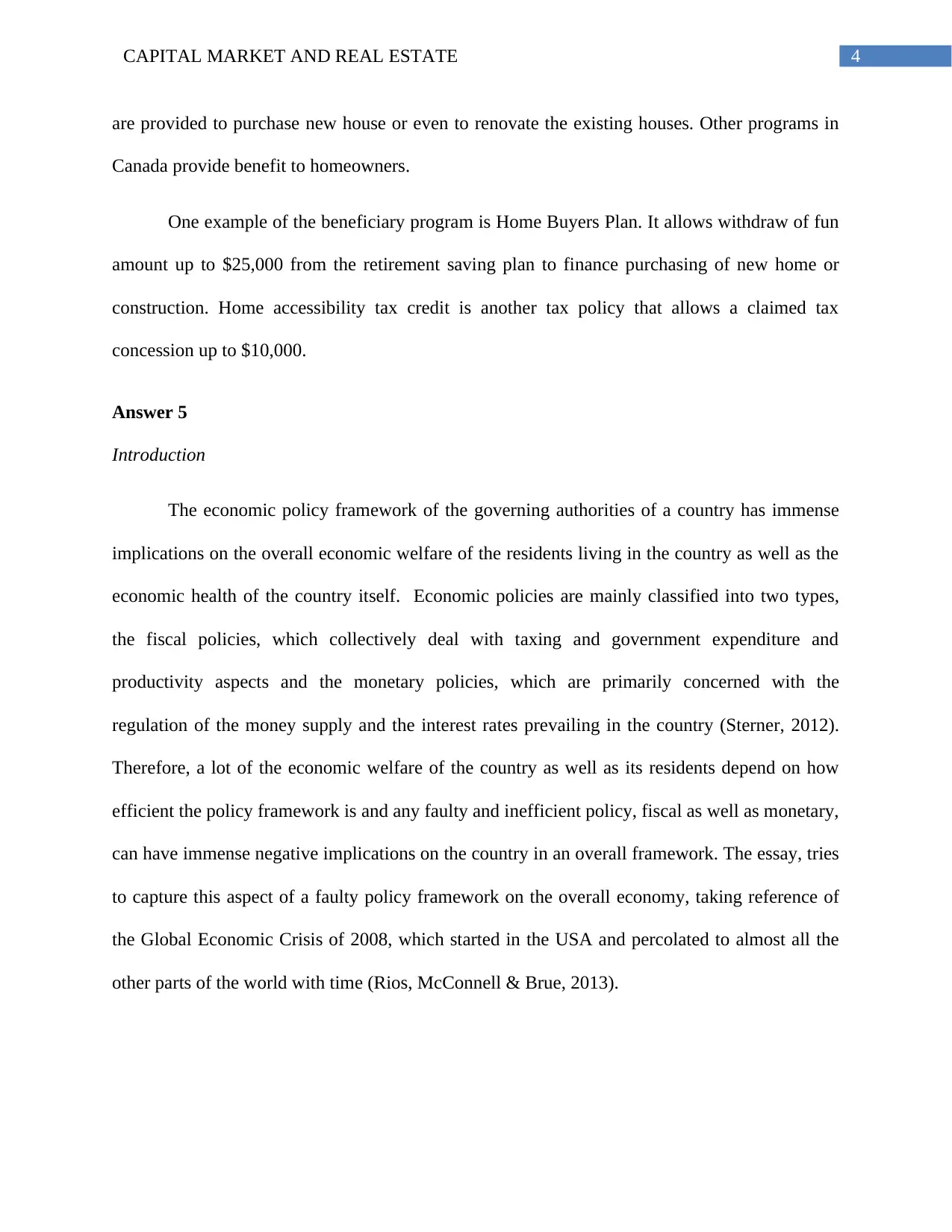
4CAPITAL MARKET AND REAL ESTATE
are provided to purchase new house or even to renovate the existing houses. Other programs in
Canada provide benefit to homeowners.
One example of the beneficiary program is Home Buyers Plan. It allows withdraw of fun
amount up to $25,000 from the retirement saving plan to finance purchasing of new home or
construction. Home accessibility tax credit is another tax policy that allows a claimed tax
concession up to $10,000.
Answer 5
Introduction
The economic policy framework of the governing authorities of a country has immense
implications on the overall economic welfare of the residents living in the country as well as the
economic health of the country itself. Economic policies are mainly classified into two types,
the fiscal policies, which collectively deal with taxing and government expenditure and
productivity aspects and the monetary policies, which are primarily concerned with the
regulation of the money supply and the interest rates prevailing in the country (Sterner, 2012).
Therefore, a lot of the economic welfare of the country as well as its residents depend on how
efficient the policy framework is and any faulty and inefficient policy, fiscal as well as monetary,
can have immense negative implications on the country in an overall framework. The essay, tries
to capture this aspect of a faulty policy framework on the overall economy, taking reference of
the Global Economic Crisis of 2008, which started in the USA and percolated to almost all the
other parts of the world with time (Rios, McConnell & Brue, 2013).
are provided to purchase new house or even to renovate the existing houses. Other programs in
Canada provide benefit to homeowners.
One example of the beneficiary program is Home Buyers Plan. It allows withdraw of fun
amount up to $25,000 from the retirement saving plan to finance purchasing of new home or
construction. Home accessibility tax credit is another tax policy that allows a claimed tax
concession up to $10,000.
Answer 5
Introduction
The economic policy framework of the governing authorities of a country has immense
implications on the overall economic welfare of the residents living in the country as well as the
economic health of the country itself. Economic policies are mainly classified into two types,
the fiscal policies, which collectively deal with taxing and government expenditure and
productivity aspects and the monetary policies, which are primarily concerned with the
regulation of the money supply and the interest rates prevailing in the country (Sterner, 2012).
Therefore, a lot of the economic welfare of the country as well as its residents depend on how
efficient the policy framework is and any faulty and inefficient policy, fiscal as well as monetary,
can have immense negative implications on the country in an overall framework. The essay, tries
to capture this aspect of a faulty policy framework on the overall economy, taking reference of
the Global Economic Crisis of 2008, which started in the USA and percolated to almost all the
other parts of the world with time (Rios, McConnell & Brue, 2013).
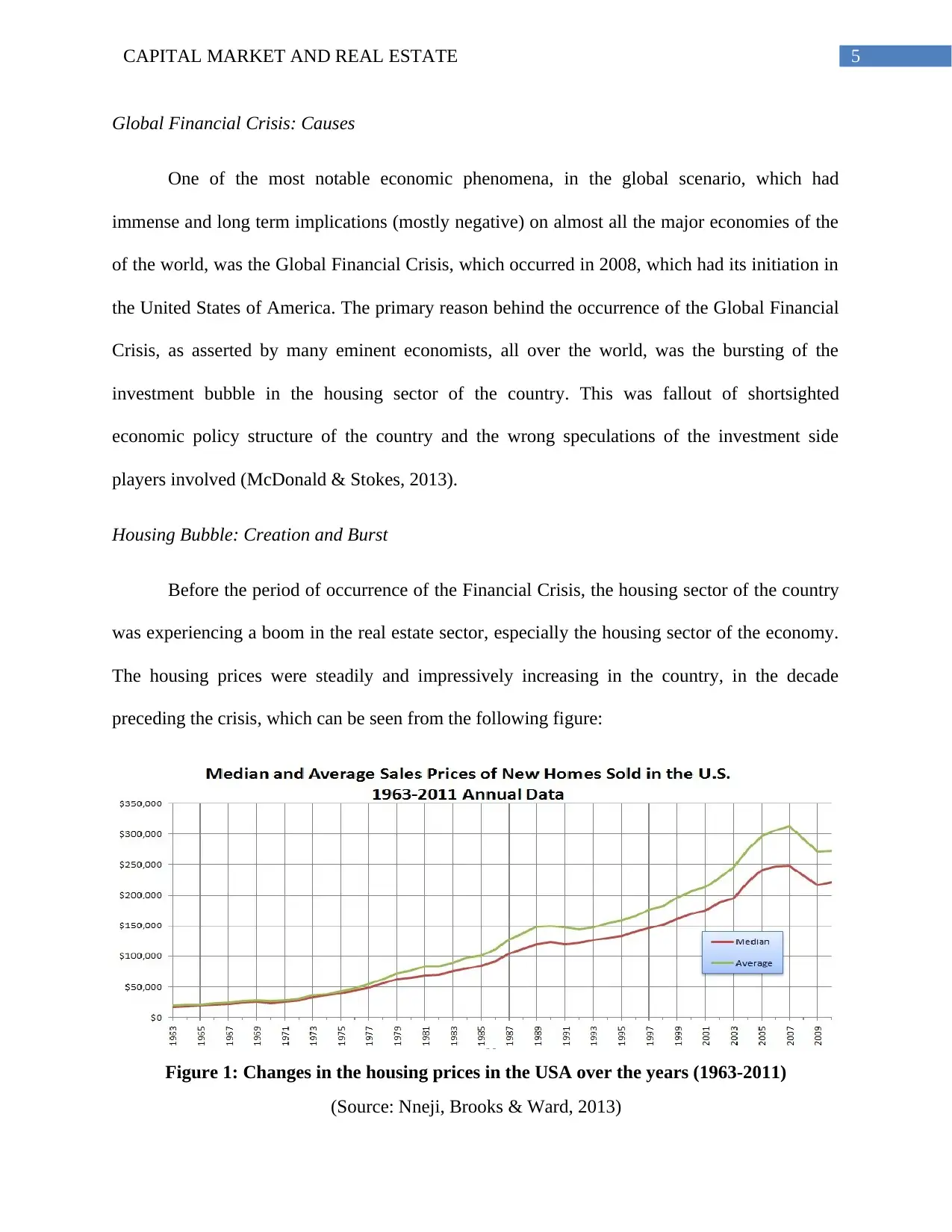
5CAPITAL MARKET AND REAL ESTATE
Global Financial Crisis: Causes
One of the most notable economic phenomena, in the global scenario, which had
immense and long term implications (mostly negative) on almost all the major economies of the
of the world, was the Global Financial Crisis, which occurred in 2008, which had its initiation in
the United States of America. The primary reason behind the occurrence of the Global Financial
Crisis, as asserted by many eminent economists, all over the world, was the bursting of the
investment bubble in the housing sector of the country. This was fallout of shortsighted
economic policy structure of the country and the wrong speculations of the investment side
players involved (McDonald & Stokes, 2013).
Housing Bubble: Creation and Burst
Before the period of occurrence of the Financial Crisis, the housing sector of the country
was experiencing a boom in the real estate sector, especially the housing sector of the economy.
The housing prices were steadily and impressively increasing in the country, in the decade
preceding the crisis, which can be seen from the following figure:
Figure 1: Changes in the housing prices in the USA over the years (1963-2011)
(Source: Nneji, Brooks & Ward, 2013)
Global Financial Crisis: Causes
One of the most notable economic phenomena, in the global scenario, which had
immense and long term implications (mostly negative) on almost all the major economies of the
of the world, was the Global Financial Crisis, which occurred in 2008, which had its initiation in
the United States of America. The primary reason behind the occurrence of the Global Financial
Crisis, as asserted by many eminent economists, all over the world, was the bursting of the
investment bubble in the housing sector of the country. This was fallout of shortsighted
economic policy structure of the country and the wrong speculations of the investment side
players involved (McDonald & Stokes, 2013).
Housing Bubble: Creation and Burst
Before the period of occurrence of the Financial Crisis, the housing sector of the country
was experiencing a boom in the real estate sector, especially the housing sector of the economy.
The housing prices were steadily and impressively increasing in the country, in the decade
preceding the crisis, which can be seen from the following figure:
Figure 1: Changes in the housing prices in the USA over the years (1963-2011)
(Source: Nneji, Brooks & Ward, 2013)
⊘ This is a preview!⊘
Do you want full access?
Subscribe today to unlock all pages.

Trusted by 1+ million students worldwide
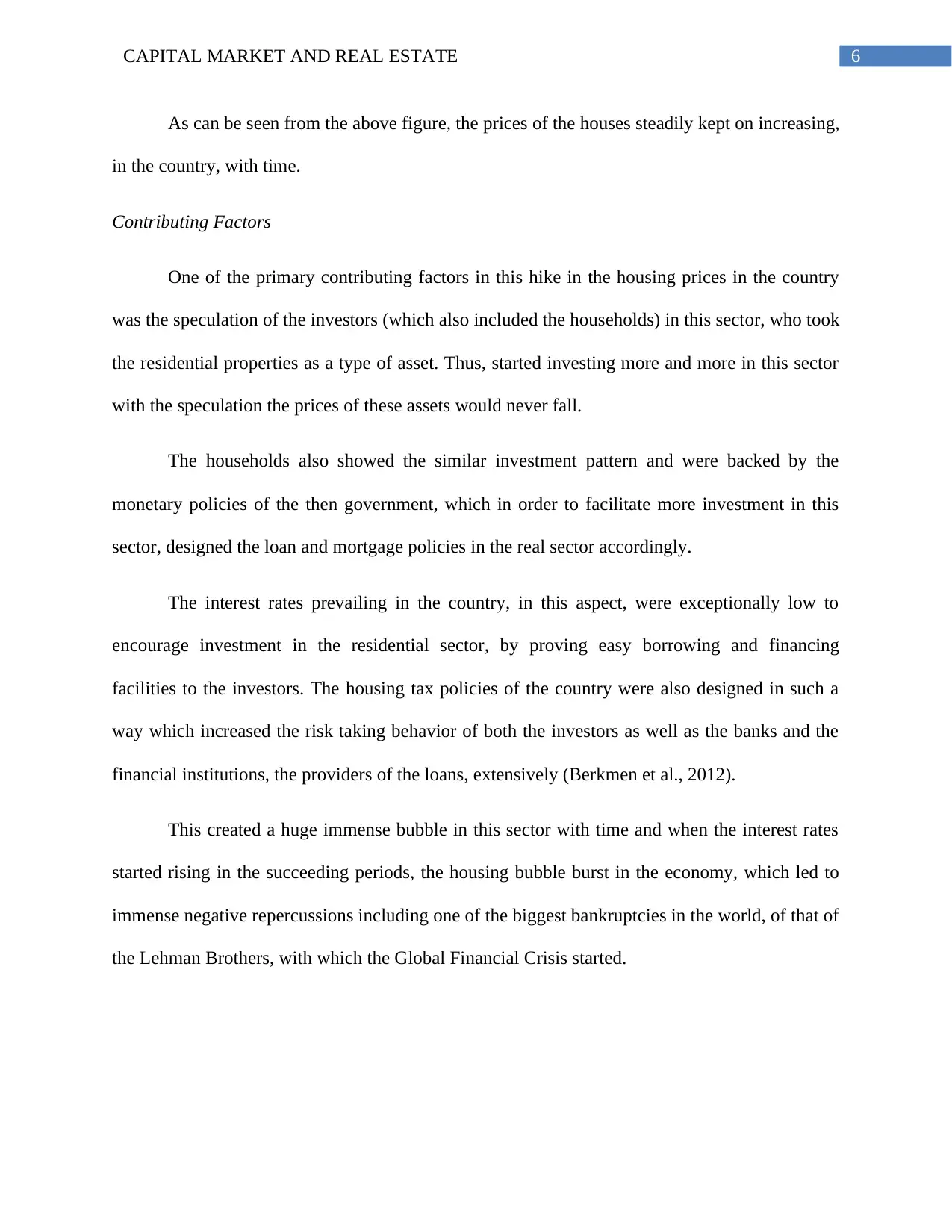
6CAPITAL MARKET AND REAL ESTATE
As can be seen from the above figure, the prices of the houses steadily kept on increasing,
in the country, with time.
Contributing Factors
One of the primary contributing factors in this hike in the housing prices in the country
was the speculation of the investors (which also included the households) in this sector, who took
the residential properties as a type of asset. Thus, started investing more and more in this sector
with the speculation the prices of these assets would never fall.
The households also showed the similar investment pattern and were backed by the
monetary policies of the then government, which in order to facilitate more investment in this
sector, designed the loan and mortgage policies in the real sector accordingly.
The interest rates prevailing in the country, in this aspect, were exceptionally low to
encourage investment in the residential sector, by proving easy borrowing and financing
facilities to the investors. The housing tax policies of the country were also designed in such a
way which increased the risk taking behavior of both the investors as well as the banks and the
financial institutions, the providers of the loans, extensively (Berkmen et al., 2012).
This created a huge immense bubble in this sector with time and when the interest rates
started rising in the succeeding periods, the housing bubble burst in the economy, which led to
immense negative repercussions including one of the biggest bankruptcies in the world, of that of
the Lehman Brothers, with which the Global Financial Crisis started.
As can be seen from the above figure, the prices of the houses steadily kept on increasing,
in the country, with time.
Contributing Factors
One of the primary contributing factors in this hike in the housing prices in the country
was the speculation of the investors (which also included the households) in this sector, who took
the residential properties as a type of asset. Thus, started investing more and more in this sector
with the speculation the prices of these assets would never fall.
The households also showed the similar investment pattern and were backed by the
monetary policies of the then government, which in order to facilitate more investment in this
sector, designed the loan and mortgage policies in the real sector accordingly.
The interest rates prevailing in the country, in this aspect, were exceptionally low to
encourage investment in the residential sector, by proving easy borrowing and financing
facilities to the investors. The housing tax policies of the country were also designed in such a
way which increased the risk taking behavior of both the investors as well as the banks and the
financial institutions, the providers of the loans, extensively (Berkmen et al., 2012).
This created a huge immense bubble in this sector with time and when the interest rates
started rising in the succeeding periods, the housing bubble burst in the economy, which led to
immense negative repercussions including one of the biggest bankruptcies in the world, of that of
the Lehman Brothers, with which the Global Financial Crisis started.
Paraphrase This Document
Need a fresh take? Get an instant paraphrase of this document with our AI Paraphraser
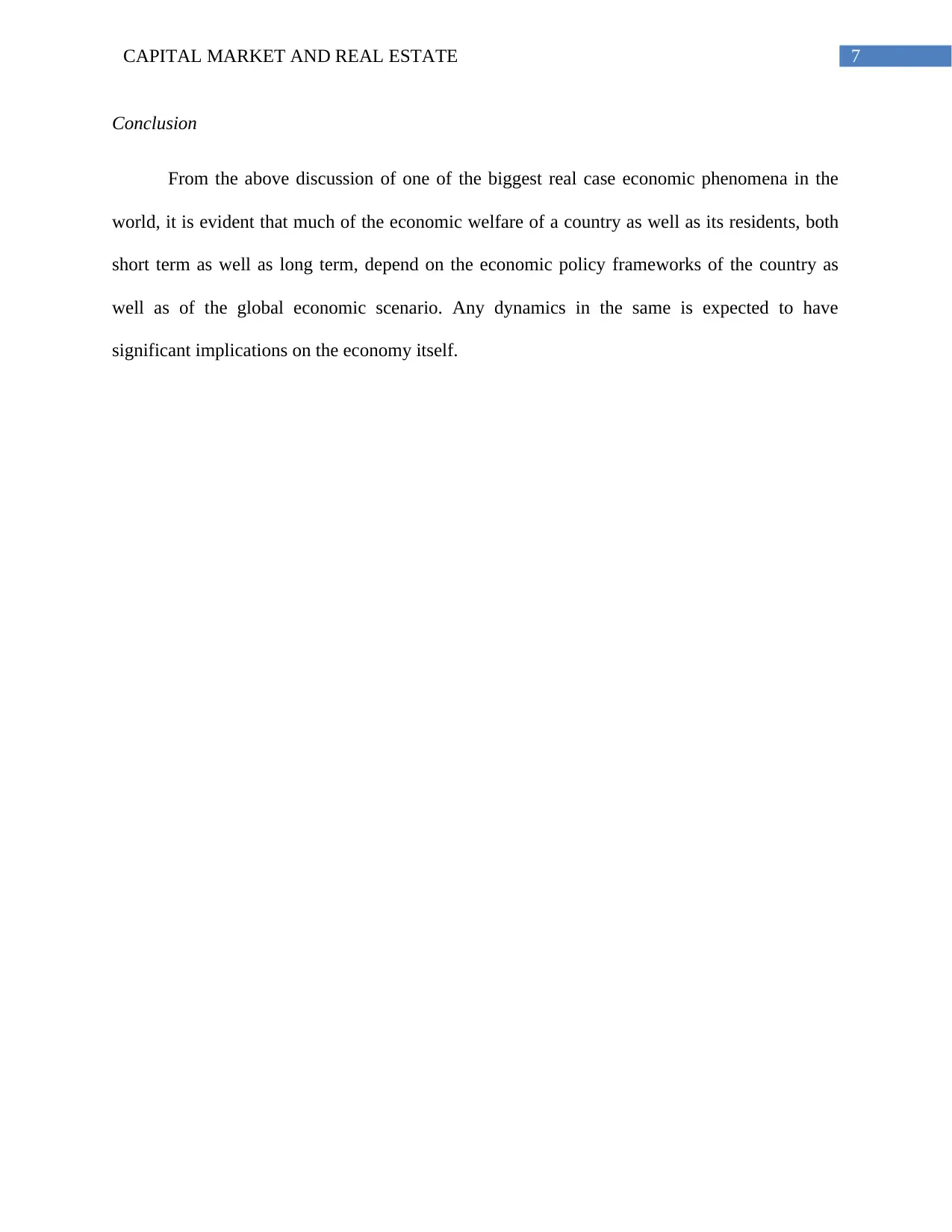
7CAPITAL MARKET AND REAL ESTATE
Conclusion
From the above discussion of one of the biggest real case economic phenomena in the
world, it is evident that much of the economic welfare of a country as well as its residents, both
short term as well as long term, depend on the economic policy frameworks of the country as
well as of the global economic scenario. Any dynamics in the same is expected to have
significant implications on the economy itself.
Conclusion
From the above discussion of one of the biggest real case economic phenomena in the
world, it is evident that much of the economic welfare of a country as well as its residents, both
short term as well as long term, depend on the economic policy frameworks of the country as
well as of the global economic scenario. Any dynamics in the same is expected to have
significant implications on the economy itself.
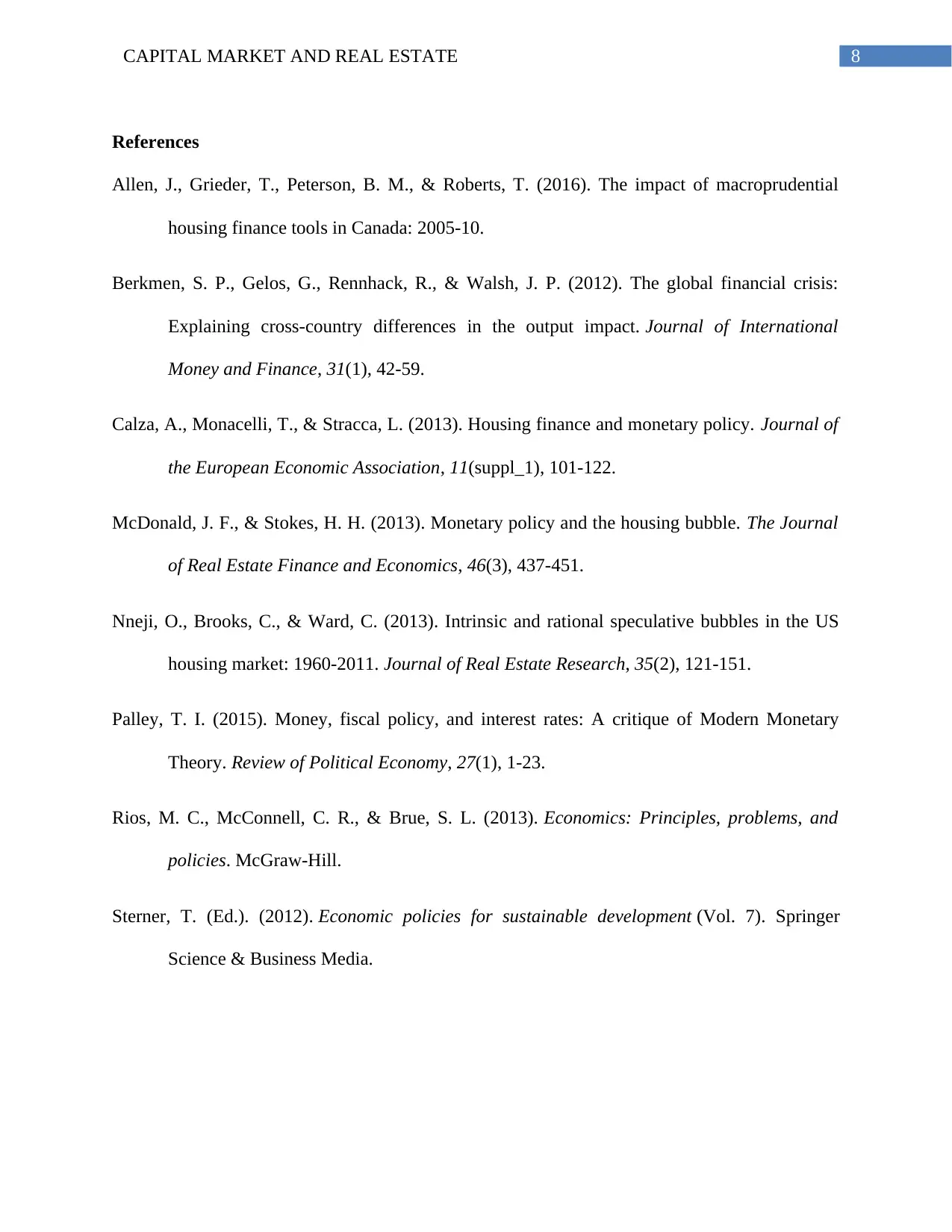
8CAPITAL MARKET AND REAL ESTATE
References
Allen, J., Grieder, T., Peterson, B. M., & Roberts, T. (2016). The impact of macroprudential
housing finance tools in Canada: 2005-10.
Berkmen, S. P., Gelos, G., Rennhack, R., & Walsh, J. P. (2012). The global financial crisis:
Explaining cross-country differences in the output impact. Journal of International
Money and Finance, 31(1), 42-59.
Calza, A., Monacelli, T., & Stracca, L. (2013). Housing finance and monetary policy. Journal of
the European Economic Association, 11(suppl_1), 101-122.
McDonald, J. F., & Stokes, H. H. (2013). Monetary policy and the housing bubble. The Journal
of Real Estate Finance and Economics, 46(3), 437-451.
Nneji, O., Brooks, C., & Ward, C. (2013). Intrinsic and rational speculative bubbles in the US
housing market: 1960-2011. Journal of Real Estate Research, 35(2), 121-151.
Palley, T. I. (2015). Money, fiscal policy, and interest rates: A critique of Modern Monetary
Theory. Review of Political Economy, 27(1), 1-23.
Rios, M. C., McConnell, C. R., & Brue, S. L. (2013). Economics: Principles, problems, and
policies. McGraw-Hill.
Sterner, T. (Ed.). (2012). Economic policies for sustainable development (Vol. 7). Springer
Science & Business Media.
References
Allen, J., Grieder, T., Peterson, B. M., & Roberts, T. (2016). The impact of macroprudential
housing finance tools in Canada: 2005-10.
Berkmen, S. P., Gelos, G., Rennhack, R., & Walsh, J. P. (2012). The global financial crisis:
Explaining cross-country differences in the output impact. Journal of International
Money and Finance, 31(1), 42-59.
Calza, A., Monacelli, T., & Stracca, L. (2013). Housing finance and monetary policy. Journal of
the European Economic Association, 11(suppl_1), 101-122.
McDonald, J. F., & Stokes, H. H. (2013). Monetary policy and the housing bubble. The Journal
of Real Estate Finance and Economics, 46(3), 437-451.
Nneji, O., Brooks, C., & Ward, C. (2013). Intrinsic and rational speculative bubbles in the US
housing market: 1960-2011. Journal of Real Estate Research, 35(2), 121-151.
Palley, T. I. (2015). Money, fiscal policy, and interest rates: A critique of Modern Monetary
Theory. Review of Political Economy, 27(1), 1-23.
Rios, M. C., McConnell, C. R., & Brue, S. L. (2013). Economics: Principles, problems, and
policies. McGraw-Hill.
Sterner, T. (Ed.). (2012). Economic policies for sustainable development (Vol. 7). Springer
Science & Business Media.
⊘ This is a preview!⊘
Do you want full access?
Subscribe today to unlock all pages.

Trusted by 1+ million students worldwide
1 out of 9
Related Documents
Your All-in-One AI-Powered Toolkit for Academic Success.
+13062052269
info@desklib.com
Available 24*7 on WhatsApp / Email
![[object Object]](/_next/static/media/star-bottom.7253800d.svg)
Unlock your academic potential
Copyright © 2020–2025 A2Z Services. All Rights Reserved. Developed and managed by ZUCOL.





